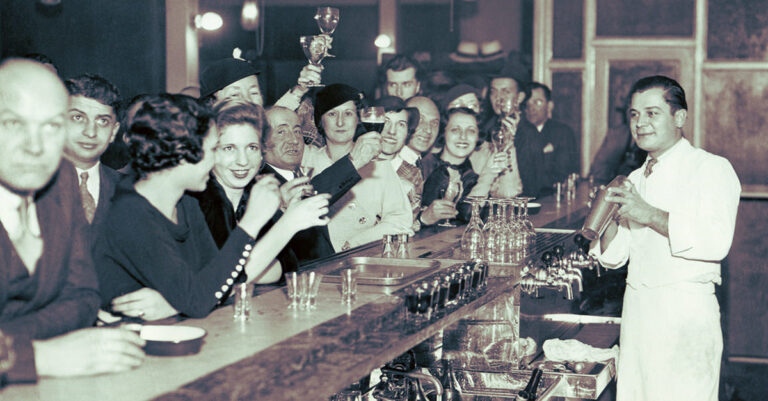
The term “bar” is derived from the typically metal bar under the counter top under which drinks are served. Patrons may sit or stand at the counter and be served by the bartender. Depending on the size of a bar and its approach, alcohol may be served at the bar by bartenders, at tables by servers, or by a combination of the two. The “back bar” is a set of shelves of glasses and bottles behind that counter. In some establishments, the back bar is elaborately decorated with woodwork, etched glass, mirrors, and lights.
The term “bar” is also derived from the metal or wooden bar that is often located at feet along the length of the “bar”.
A bar is a retail business establishment that serves alcoholic beverages, such as beer, wine, liquor, cocktails, and other beverages such as mineral water and soft drinks and often sell snack foods such as potato chips (also known as crisps) or peanuts, for consumption on premises. Some types of bars, such as pubs, may also serve food from a restaurant menu. The term “bar” also refers to the counter top and area where drinks are served.
Bars provide stools or chairs that are placed at tables or counters for their patrons. Bars that offer entertainment or live music are often referred to as music bars, live venues, or nightclubs. Types of bars range from inexpensive dive bars to elegant places of entertainment, often accompanying restaurants for dining.
A bar, also known as a saloon, a tavern or tippling house, or sometimes as a pub or club, is a retail business establishment that serves alcoholic beverages, such as beer, wine, liquor, cocktails, and other beverages such as mineral water and soft drinks. Bars often also sell snack foods, such as crisps or peanuts, for consumption on their premises. Some types of bars, such as pubs, may also serve food from a restaurant menu. The term “bar” refers to the countertop where drinks are prepared and served, and by extension to the overall premises.
HISTORY
In Saxon times, “public houses” came into existence in England, and became popular gathering places for business and personal meetings. When New Englanders began moving to the New World, “public houses” were such a large part of everyday life, that in many new colonies the town began building these (called taverns) before churches. In many towns, as far back as the 1650s it was illegal to not have a tavern offering a place for food, drink and lodging. Taverns are very integral in the fabric of this country, and it is said that the spirit of revolution that freed the new world from England’s rule was sparked in taverns.
By the 1800s, the purpose of taverns transformed into what we now call hotels, and at the same time many “saloons” appeared on every street corner. With such high numbers of “saloons” the profitability of these businesses saw a sharp decline. So to increase profits, illegal activities began being offered to patrons. By World War I Americans were so upset about the activities happening in saloons (and from intoxicated townsfolk), that the 18th Amendment was passed. The 18th Amendment made the manufacturing, sale and transportation/importation of alcohol illegal. However this was hard to enforce, as “speakeasies” and moonshining gained popularity. So after only 14 years this amendment was appealed and replaced by the 21st Amendment in 1933, making alcohol legal again, but it brought a heavy list of stiff taxes and regulations that we still use to this day.
There have been many different names for public drinking spaces throughout history. In the colonial era of the United States, taverns were an important meeting place, as most other institutions were weak. During the 19th century saloons were very important to the leisure time of the working class.[3] Today, even when an establishment uses a different name, such as “tavern” or “saloon” or, in the United Kingdom, a “pub”, the area of the establishment where the bartender pours or mixes beverages is normally called “the bar”.
The sale and/or consumption of alcoholic beverages was prohibited in the first half of the 20th century in several countries, including Finland, Iceland, Norway, and the United States. In the United States, illegal bars during Prohibition were called “speakeasies“, “blind pigs”, and “blind tigers”.
